How to Start a Food Blog in 6 Steps + Tips for Success
Launching a food blog can be an advantageous creative outlet. It is a place to share your culinary explorations and establish a connection with an audience that shares your appreciation for the niche.
This guide will explore the essential steps on how to start a food blog. We’ll also share some food blog tips for running your own blog to publish recipes, restaurant reviews, or cooking methods.
Whether you’re a kitchen novice, foodie, or seasoned chef, this tutorial will help you start your own food blog and ensure that your blog exists to inform and engage readers.

How to Start a Food Blog
Let’s explore the six steps for how to start a food blog.
1. Establish Your Food Blog Niche
One of the foundational aspects of starting a blog is determining your niche. Food blog niche selection is crucial because it defines your identity, attracts the right audience, and sets you apart from the competition.
Whether you’re building a recipe blog, writing cooking tips, or becoming a food critic, choosing a niche based on your passion and expertise is essential.
The right niche helps you create content that genuinely resonates with you and the audience, making your blogging journey more enjoyable and sustainable in the long term.
For inspiration, here are some of the most profitable blog niches in the food industry:
- Healthy eating and nutrition. Post recipes promoting a healthy lifestyle, share nutritional insights, and provide helpful tips for balanced eating. You can also offer meal planning suggestions to help readers incorporate these choices into their diet.
- Cuisine-specific. Dive deep into a specific cuisine, such as Italian, Mexican, or Japanese, and explore its flavors, techniques, and cultural aspects.
- Plant-based food. Cater to the growing audience interested in reading vegan food blog posts, like meat-free recipes, plant-based restaurant reviews, and vegan lifestyle tips.
- Local food reviews. Become a culinary explorer in your region, reviewing local restaurants, food markets, and hidden gems.
- Baking and desserts. Share your passion for sugary delicacies, from delectable snack recipes to pastry artistry techniques.
As you contemplate the niche for your new food blog, consider what makes your perspective unique. Emphasize your stories, experiences, and culinary passions, as embracing your individuality can be a powerful way to connect with the audience.
Pro Tip
Explore other blog ideas and choose one that you’re passionate about.
2. Choose a Web Host and a Domain Name
Reliable web hosting for food bloggers and a catchy domain name are essential.
Given the specific needs of culinary content creators, getting the right web hosting for food bloggers is critical. It ensures their websites are reliable, fast, and capable of handling media like high-resolution cooking photos and videos.
For convenient blog creation, opt for our Hostinger’s blog website builder. Utilize the AI-powered tools and customizable templates to personalize the web design.
This solution also includes a web hosting plan, a drag-and-drop editor, and third-party integrations. Such features are useful for quickly launching and marketing your food blog. Plus, its built-in eCommerce tools in the Business plan and above are excellent if you decide to sell merchandise or recipe books online.
As a reliable web host, Hostinger guarantees a 99.9% uptime, top-notch security, excellent performance, and various customer support channels.
We also offer managed WordPress hosting solutions for users interested in starting a food blog with a content management system (CMS) instead. Plans include auto-updates, a vulnerability scanner, and WordPress acceleration using LiteSpeed Cache.
Meanwhile, a carefully chosen domain name serves as your blog’s unique online address. It is also your food blog’s online identity and the key to making a lasting impression.
Here are some tips for choosing a good domain as well as a blog name:
- Reflect on your niche. Your domain name should tell readers what your blog is about, so using relevant keywords is a good strategy. If you specialize in Italian cuisine, some domain name examples include italiankitchen.com and pastapassion.com.
- Keep it simple. Short domain names are more memorable and easier to type. An ideal domain name is between five and 10 characters.
- Avoid special symbols. Hyphens and special characters can confuse users and make your domain name harder to remember. Stick to letters and, only if necessary, numbers.
- Check for availability. Once you come up with a few ideas, check if the domain names are available. You can use domain registration websites or domain search tools to do this.
- Think long-term. Choose a domain name that is evergreen so it’s still relevant even as your blog grows and evolves.
- Secure social media handles. Check if the name is available as a social media handle on platforms like Instagram and Twitter to ensure you maintain consistent branding across various channels.
Hostinger aids in domain registration by offering a free domain name for clients with its hosting plans. Plus, we provide a domain name search tool, various extensions, and domain transfer assistance.
We also offer an AI-powered domain generator. This tool can inspire creative food blog domain name ideas relevant to your niche, such as gourmetitalianbites.com and mangiaritaliano.com.
By choosing our web hosting plans for your hosting and domain needs, you ease the process of creating, launching, and maintaining a food blogging site.
3. Design Your Blog
Designing a website that suits your niche is vital for attracting and keeping readers. While web design can be tricky, choosing the right blogging platform can help ease the technicalities.
With Hostinger Website Builder, designing a blog is straightforward. Here’s how to use our AI-powered website builder:
1. From hPanel, access our builder’s user-friendly interface and click on TRY AI WEBSITE BUILDER.
2. Type in your brand name, website type, and a short description of your food blog. Then, click Create a website.
3. Our AI-powered blogging platform will automatically generate a customized site for you in a few minutes.
4. Next, customize the website elements using our intuitive editor and write the blog content.
Alternatively, you can choose from dozens of our pre-made templates and adjust the sample pages to your preference. Start by filtering the category and selecting a food blog theme.
Once you choose a template, follow the onboarding checklist on our user-friendly editing interface to help with customization. Generally, here are the web elements to adjust:
1. Text. Click on the element and hit Edit text to rewrite the blog title, subtitle, and content.
2. Background. Select a section, then click Edit section to upload images or change the background color.
3. Logo. In the header section, click Edit header to upload your custom logo.
4. Layout. Click on the blog preview section, then select Edit blog list to adjust the display.
5. Social media channels. Scroll down to the footer and click on the social media section. Choose Edit social icons to start syncing your accounts.
If you want to start a WordPress blog, install a food blog theme and a recipe plugin to extend the site’s functionality.
The CMS has an official theme directory with hundreds of free food blog themes, while other marketplaces provide premium options for purchase. Some theme developers, like Astra, also offer food-specific templates.
Explore its official plugin directory to add specific features to your WordPress website. For a food blogger, WP Recipe Maker, Cooked, and Recipe Box are some of the best recipe plugins to consider.
In addition to a recipe plugin, install a contact form plugin like WPForms or Contact Form 7 to encourage engagement and boost your email marketing list. Meanwhile, Akismet is a great plugin choice for filtering spam comments.
4. Create High-Quality Content
Writing high-quality posts is the cornerstone of a successful food blog. For this, you need to provide the audience with something engaging, regardless of your blog post ideas.
When writing recipes for a food blog, do it clearly and concisely. Use step-by-step instructions and be mindful of your audience’s cooking skill levels. Include detailed ingredient measurements, cooking times, and special techniques or tips to make your own recipes stand out.
The same goes for when you write a food review blog post. This type of content involves sharing about your dining experience at a restaurant or with a specific dish.
To create a compelling review, use descriptive language when explaining the ambiance, service, and the food’s taste. Then, don’t forget to mention the restaurant’s name, location, and price range. Not only is this useful for readers, but it’s also good for your blog’s search engine optimization.
Many food bloggers also infuse their posts with personal stories based on the blog’s style and tone. For example, make your readers feel like they’re right there with you in the kitchen, sharing a friendly conversation.
Hostinger Website Builder offers one of the best AI content generators to help you craft blog posts in a few clicks. Here’s a guide to get started:
1. From the editing interface, navigate to Blog → ADD NEW POST.
2. In the pop-up window, choose the tone of voice, adjust the content length, and fill out the description field.
3. Click Create content to let the AI tool generate the blog post.
High-quality images are also essential if you want to be a food blogger. Crisp, well-composed photos make your cooking blog look enticing and encourage readers to try your recipes.
Be sure to research food photography for bloggers – natural light is key when it comes to food photography. Shoot your dishes near a window with diffused light to achieve a soft glow. Also, consider investing in quality photography equipment or hiring a professional photographer to ensure optimal results.
5. Market Your Blog
Effective marketing is crucial for food blogs. Besides creating quality content, targeted blog promotion helps ensure you reach the right audience.
Search engine optimization (SEO) helps grow your site’s visibility and attract organic traffic. Conduct keyword research to discover relevant phrases and incorporate them into your blog posts. This lets you create high-quality, informative content that addresses your readers’ needs.
Meanwhile, promoting a food blog on social media helps engage your target audience effectively. Create accounts on popular social media channels and tailor your content to leverage each platform’s unique strengths.
Visual social media channels like Instagram and TikTok excel in showcasing visually appealing food photos and videos, making them ideal for food bloggers.
Facebook is well suited for sharing longer-form content such as detailed recipes and informative articles. On the other hand, Twitter is an effective platform for sharing brief updates and posting links to your blog content.
Additionally, Pinterest can drive significant traffic by leveraging eye-catching graphics and strategically pinning your blog posts to relevant boards.
At the same time, email marketing is a powerful tool for building and nurturing relationships with readers. To build an email list, offer incentives like a free recipe eBook in exchange for users’ emails.
Send regular newsletters with exclusive blog updates. Ensure to personalize the emails and segment your list to deliver tailored content that resonates with subscribers.
Hostinger Business Email helps streamline your email marketing strategies. You can seamlessly integrate it with your food blog, providing advanced features like read receipts, email templates, and ample storage.

6. Monetize Your Blog
When starting a food blog, it’s crucial to understand how to monetize it and turn it into a profitable business.
Consider these monetization strategies for food blogs:
- Become an affiliate. Partner with other individuals or companies and promote their products or services on your blog. For every sale generated through your unique affiliate links, you’ll earn a commission.
- Implement pay-per-click advertising. Utilize Google AdSense to display targeted ads on your food blogging site. When visitors click on these ads, you generate revenue from advertisers.
- Write sponsored content. Collaborate with brands and businesses that align with your blog’s content and niche. You can promote their products or services through sponsored posts, product reviews, or brand endorsements in exchange for a fee.
- Sell digital products. Leverage your expertise and culinary creativity by selling digital products like eBooks, meal plans, and online cooking courses.
- Build a membership program. Let visitors subscribe to exclusive content or services. Ideas include premium recipes, in-depth cooking tutorials, personalized consultations, or an active community forum.
Suggested Reading
Looking for more ways to monetize? Check out our article on top food business ideas for fresh inspiration.
Tips for Running a Successful Food Blog
Running a food blog requires careful planning and consistent effort. Consider these essential tips for how to become a food blogger and ensure success.
Create an Editorial Calendar
Creating an editorial calendar enables you to schedule your blog posts in advance, ensuring a steady flow of content for readers.
Strive for content variety by publishing recipes, food narratives, and informative articles in turn. Allocate ample time for research and development to guarantee everything is prepared before posting.
Then, determine realistic posting frequencies that allow you to manage your workload effectively, preventing content burnout. This strategy also upholds the quality of your posts.
The ideal posting frequency varies based on your niche, audience, and personal capacity. Experiment with different schedules to discover what works best for you and your readers. Monitor engagement and feedback to refine your posting schedule.
Consider standard options like weekly, bi-weekly, and monthly posting. Alternatively, opt for a more adaptable approach by publishing when you have valuable content to share. A flexible schedule can work as long as you don’t go too long without posting content.
Engage with Your Audience
Building a successful culinary website often means creating a thriving food blog community.
Engagement with your audience starts with encouraging participation in your posts and joining the discussion when readers comment on your blog. Take the time to read their feedback and respond genuinely. By providing thoughtful replies, you show that you value their input.
However, your reach extends beyond your blogging site.
Use social media platforms to showcase your blogging journey, host interactive Q&A sessions, and share behind-the-scenes moments. Actively interacting with your followers through comments and direct messages also helps build genuine interest in your food blog.
Deliver exclusive content, like sneak peeks of upcoming blog posts, through email newsletters to make your subscribers feel valued. You can also share blog post summaries highlighting the key takeaways, enabling subscribers to catch up on what they might have missed.
Monitor and Analyze Blog Performance
Food blog analytics and tracking involves collecting data about how readers interact with your content.
Data analytics tools can help you track traffic and user behavior. For example, Google Analytics lets you assign a tracking code to your blog’s HTML, gaining insights into three crucial aspects:
- Visitors. Get a comprehensive understanding of your audience demographics, interests, and behaviors by exploring the Audience section.
- User behavior. Dive into how users interact with your content, such as which articles they read most, their average session duration, and bounce rates, in the Behavior section.
- Traffic sources. Discover where your traffic originates, whether from search engines, social media platforms, or other websites, by accessing the Acquisition section.
If you’re a food blogger writing a wide range of topics, analyzing user behavior can refine your content strategy effectively. It reveals which content type resonates most with your audience, whether recipes, restaurant reviews, or culinary tips.
Keep in mind that analysis is an ongoing process. Continuously reviewing and adjusting your approach based on performance data keeps your blog fresh. Additionally, keeping up with food blogging trends is essential to maintain relevance and cater to evolving reader preferences.
Suggested Reading
Check out our articles about Google Tools: Google Analytics 4 Tutorial and How to Use Google Ads
Optimize Your Blog for Mobile and User Experience
Mobile phones account for approximately 58% of global website traffic, making mobile optimization for food blogs important.
Ensure your blog employs a mobile-responsive web design, automatically adjusting its layout and content to suit various screen sizes. Whether your readers access it from a smartphone, tablet, or desktop, they should enjoy a seamless browsing experience.
You should also optimize images and content for mobile devices. The process involves resizing media files to ensure that every element on your blogging site is readable on smaller screens.
Another essential component of a positive user experience is a fast-loading website.
Slow-loading pages can drive away visitors and negatively impact your search engine rankings. Implement tools and techniques to enhance loading speed. Aside from image optimization, you can minify code and employ browser caching.
Given the ever-evolving mobile landscape, it’s crucial to test your blog’s mobile responsiveness periodically. This practice ensures your blogging site remains mobile-friendly as new devices and screen sizes emerge.
Pro Tip
Learn more about website optimization and building an SEO-friendly website.
Build Trust and Authenticity
Building trust in food blogging is fundamental for success.
Be transparent with your audience whenever you create sponsored content or engage in affiliate partnerships. Transparency not only builds trust but also ensures ethical blogging practices.
Furthermore, be authentic to allow readers to connect with you more deeply. For this, incorporate storytelling to make your blogging site more personable and relatable.
If you review products or recommend services, maintain honesty and integrity. Ensure your reviews are fair and unbiased so readers trust your opinion. This integrity strengthens your reputation as a reliable source of information.
Trust is a valuable asset that can lead to a loyal and engaged readership. By consistently demonstrating transparency, authenticity, and ethical conduct, your food blog can become a trusted resource in your niche.
Network and Collaborate
Expand your horizons by networking with other food bloggers and professionals in the industry. Collaboration can lead to exciting opportunities, like guest posts and joint projects.
When collaborating with other food bloggers, ensure the partnership is mutually beneficial. Look for opportunities to cross-promote each other’s blogs or co-host virtual events. By working together, you can reach a broader readership.
Also, consider attending food-related events, conferences, and workshops.
These gatherings offer excellent opportunities to meet like-minded individuals and industry experts. You can exchange ideas, gain insights, and stay updated on the latest trends in the culinary world.
Conclusion
Starting a food blog is rewarding if you are passionate about sharing culinary adventures with others.
Here’s a recap of our beginner’s guide on how to start a food blog and make money from it:
- Establish your food blog niche. A niche helps shape your identity, attract the right audience, and make you stand out. Options range from healthy eating tips to local food reviews and baking recipes.
- Choose a web host and a domain name. Hostinger offers reliable blog-building solutions, with plans including hosting, a domain name, an AI-powered builder, eCommerce functionality, and marketing tools.
- Design the blog. Our AI-powered website builder simplifies web design processes. For WordPress users, be sure to install a food blog theme and food-specific plugins.
- Create high-quality content. Write descriptive food review posts, incorporate personal storytelling, and upload well-lit, high-quality photographs.
- Market your blog. Effective food blog marketing involves search engine optimization for traffic, social media engagement for visibility, and email marketing for exclusive and personalized content.
- Implement monetization strategies. As your blog grows in popularity, consider affiliate marketing for commission-based earnings and sponsorships for brand collaborations.
Also, remember to focus on your unique voice and share personal stories to connect with your audience on a deeper level.
Following the six steps in this guide, you can establish a successful food blogging site that stands out. Good luck on your food blogging journey!
Check out these articles to help you start a successful food blog:
How to Make a Website From Scratch
18 Tips to Write SEO-Friendly Content
How to Drive Traffic to Your Website
How to Make Money Blogging
How to Use ChatGPT for Blogging
How to Start a Food Blog FAQ
This section answers the most asked questions about food blogging for beginners.
Do I Need Any Special Skills to Start a Food Blog?
No, you don’t need any special skills to start a food blog. However, having basic photography, writing, and culinary knowledge can be helpful. Utilize online tutorials and resources to learn and improve these skills.
How Much Does It Cost to Start a Food Blog?
The cost of starting your own food blog varies depending on your needs, preferences, and blogging platform. It can range from a few dollars monthly for basic hosting and a domain name to hundreds per month for premium themes, plugins, and third-party extensions. With Hostinger Website Builder, you can start a food blog from just ₹149.00/month with all the essentials included.
How Often Should I Publish New Content on My Food Blog?
We recommend publishing new blog content on your food blog at least once a week. However, it’s ideal to publish two to three times per week to keep your readers engaged. Regardless of your editorial schedule, prioritize quality over quantity and ensure that your content is well-researched, visually appealing, and informative to your audience.


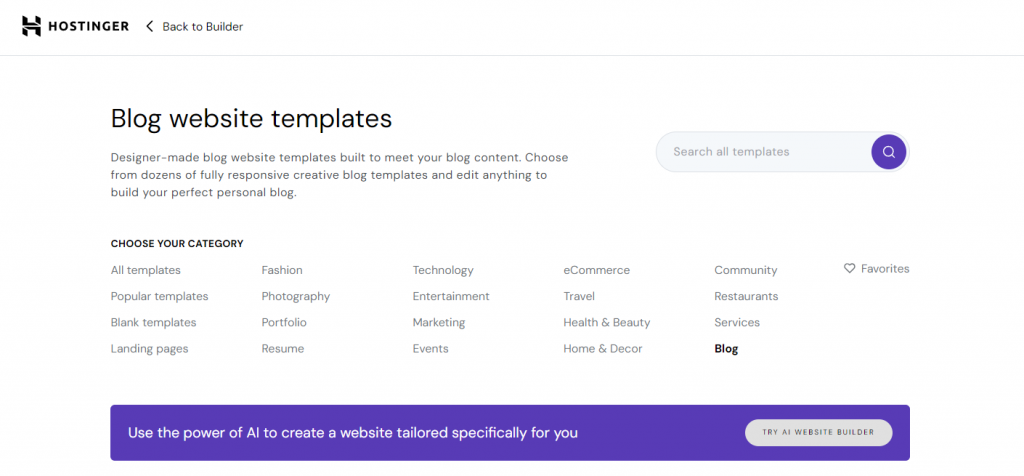
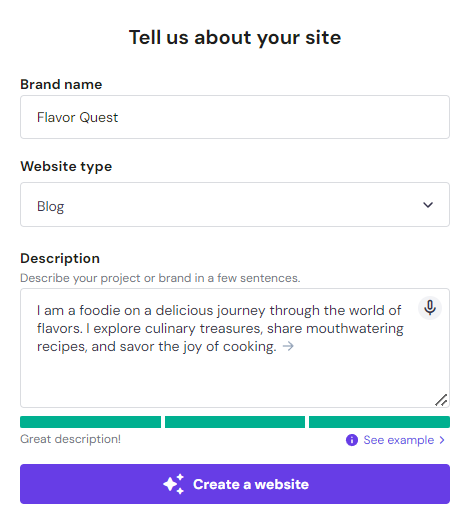
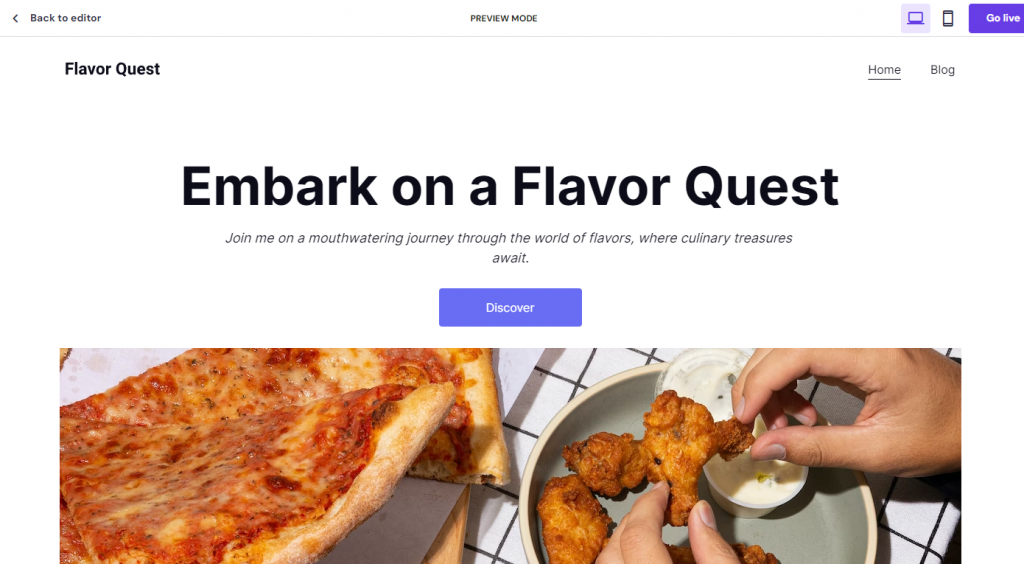
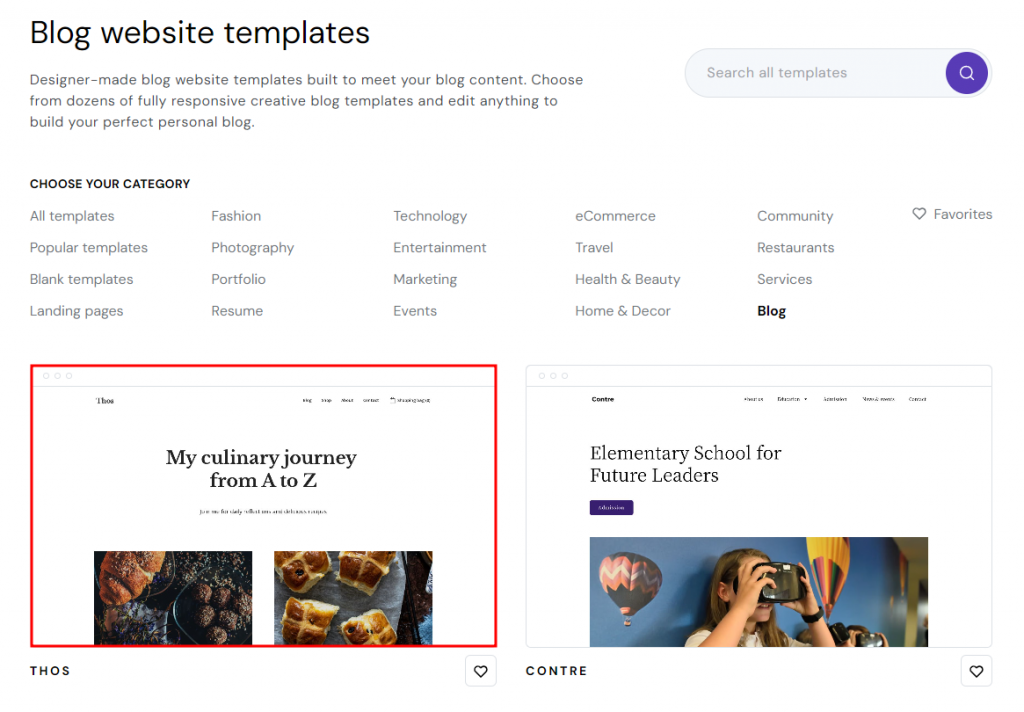
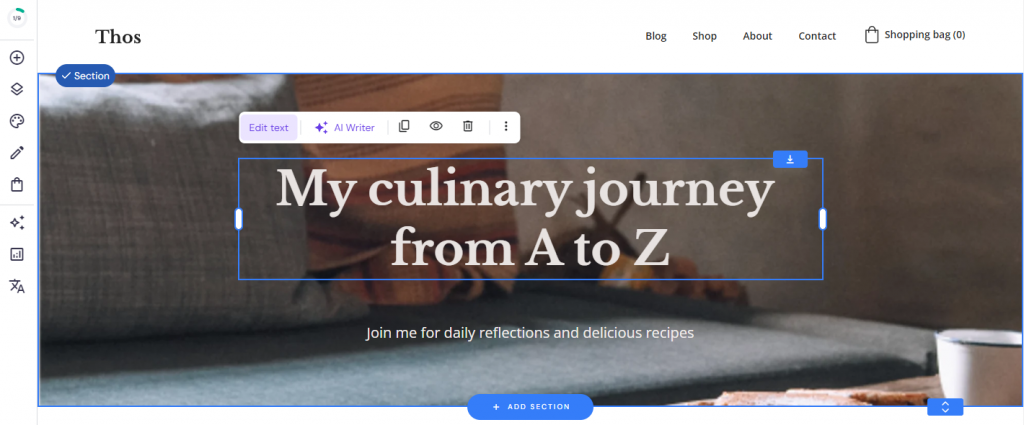
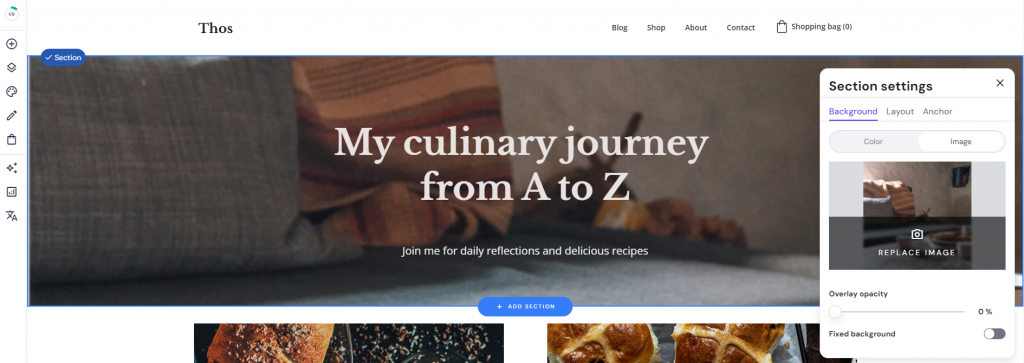

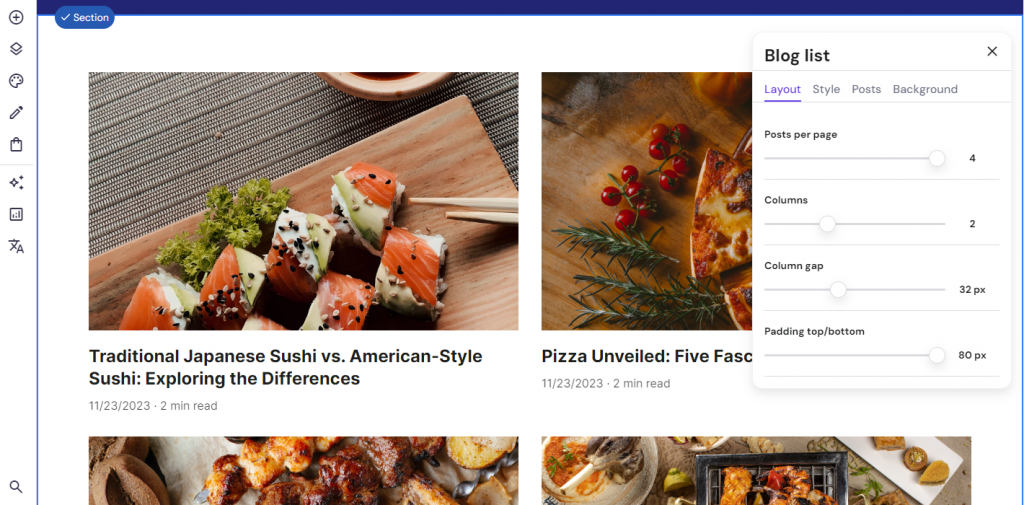
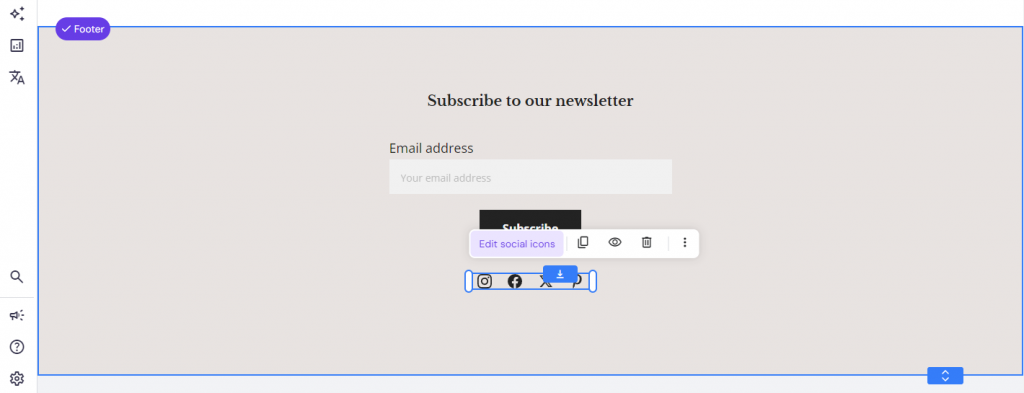
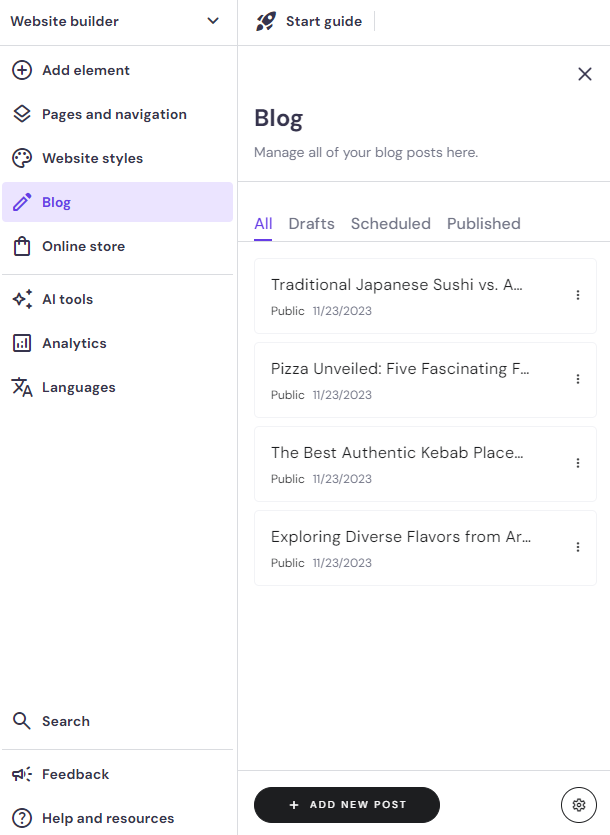
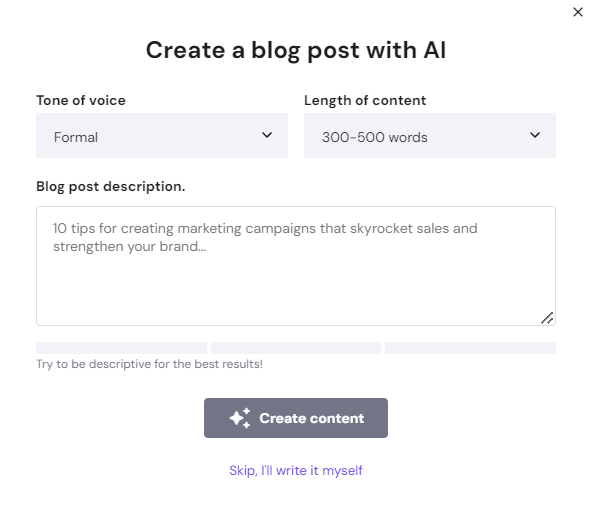




Comments
July 23 2019
This gives the idea how to start a food blog that earns you money in 5 steps. It gives the detailed information about it which is very useful for the people. It tells us how to create website through WordPress which is very simple to create.
October 01 2021
Thanks for sharing the blog with an informative content. We love read the blogs related to nutrition which is good for our health. Keep sharing more. We are having same type of services. You can read it too.
February 06 2022
Thanks for this list. I have check all of these websites all are in working condition.
November 14 2023
Thank you for this information,honestly you have have brought me back on track ❤️
November 22 2023
You're welcome! Delighted to hear you're back on track. Happy blogging ?